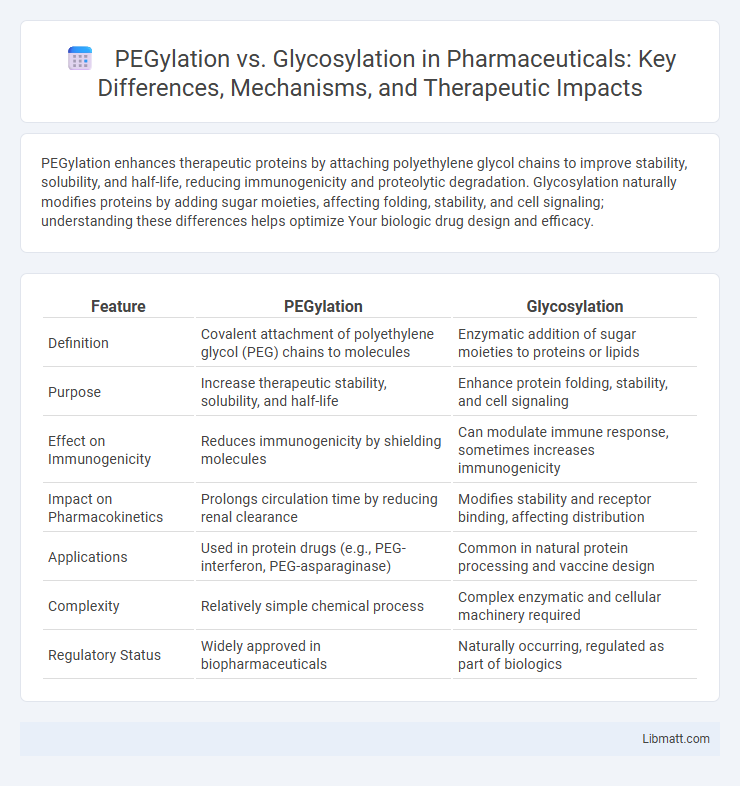PEGylation enhances therapeutic proteins by attaching polyethylene glycol chains to improve stability, solubility, and half-life, reducing immunogenicity and proteolytic degradation. Glycosylation naturally modifies proteins by adding sugar moieties, affecting folding, stability, and cell signaling; understanding these differences helps optimize Your biologic drug design and efficacy.
Table of Comparison
| Feature | PEGylation | Glycosylation |
|---|---|---|
| Definition | Covalent attachment of polyethylene glycol (PEG) chains to molecules | Enzymatic addition of sugar moieties to proteins or lipids |
| Purpose | Increase therapeutic stability, solubility, and half-life | Enhance protein folding, stability, and cell signaling |
| Effect on Immunogenicity | Reduces immunogenicity by shielding molecules | Can modulate immune response, sometimes increases immunogenicity |
| Impact on Pharmacokinetics | Prolongs circulation time by reducing renal clearance | Modifies stability and receptor binding, affecting distribution |
| Applications | Used in protein drugs (e.g., PEG-interferon, PEG-asparaginase) | Common in natural protein processing and vaccine design |
| Complexity | Relatively simple chemical process | Complex enzymatic and cellular machinery required |
| Regulatory Status | Widely approved in biopharmaceuticals | Naturally occurring, regulated as part of biologics |
Introduction to PEGylation and Glycosylation
PEGylation involves the covalent attachment of polyethylene glycol (PEG) chains to biomolecules, enhancing their solubility, stability, and half-life in therapeutic applications. Glycosylation, a natural enzymatic process, adds oligosaccharide chains to proteins or lipids, influencing protein folding, stability, and immune recognition. Understanding these modifications is crucial for optimizing drug design and improving your biopharmaceutical performance.
Fundamental Principles of PEGylation
PEGylation involves the covalent attachment of polyethylene glycol (PEG) chains to biomolecules, enhancing their solubility, stability, and circulation time by creating a hydrophilic shield that reduces immunogenicity and proteolytic degradation. This process relies on site-specific or random conjugation techniques targeting amino groups, thiols, or other reactive sites on proteins or peptides to optimize therapeutic efficacy. Understanding PEGylation's fundamental principles allows you to modify drugs effectively, improving pharmacokinetics without significantly altering biological activity.
Core Concepts of Glycosylation
Glycosylation involves the enzymatic attachment of sugar moieties to proteins or lipids, creating glycoproteins and glycolipids essential for cellular recognition and signaling. This post-translational modification profoundly influences protein folding, stability, and immunogenicity by altering molecular interactions and half-life. Your understanding of glycosylation core concepts clarifies its critical role in therapeutic protein design compared to PEGylation, which primarily enhances solubility and circulation time without mimicking natural biological processes.
Mechanisms of Action: PEGylation vs Glycosylation
PEGylation involves the covalent attachment of polyethylene glycol (PEG) chains to therapeutic proteins, enhancing solubility, stability, and circulation time by sterically hindering proteolytic enzymes and immune recognition. Glycosylation, a natural post-translational modification, attaches carbohydrate moieties to proteins, influencing folding, stability, and cell signaling through specific receptor interactions and immune modulation. Both mechanisms improve protein pharmacokinetics but operate via distinct biochemical pathways: PEGylation provides a synthetic, non-specific shield, while glycosylation imparts biologically active, site-specific modifications.
Impact on Protein Stability and Solubility
PEGylation significantly enhances protein stability by shielding the protein from enzymatic degradation and reducing immunogenicity, thereby prolonging its half-life in biological systems. Glycosylation improves protein solubility and stability by promoting proper folding and protecting against aggregation through carbohydrate moieties, also aiding in biological activity and recognition. Understanding the effects of PEGylation and glycosylation on your protein's stability and solubility can guide the optimization of therapeutic protein design for improved efficacy.
Effects on Pharmacokinetics and Pharmacodynamics
PEGylation enhances pharmacokinetics by increasing drug stability, reducing renal clearance, and extending half-life, which improves bioavailability and reduces dosing frequency. Glycosylation influences pharmacodynamics by modulating protein folding, stability, and receptor interactions, leading to altered efficacy and immune recognition. Your drug's therapeutic profile can benefit significantly from tailored PEGylation to optimize circulation time, while glycosylation adjustments refine target specificity and activity.
Immunogenicity: Comparing PEGylation and Glycosylation
PEGylation reduces immunogenicity by shielding proteins with polyethylene glycol chains, thereby decreasing recognition by the immune system and prolonging circulation time. In contrast, glycosylation modulates immunogenicity by adding carbohydrate moieties that promote biocompatibility and proper protein folding, which can also mask antigenic sites. The choice between PEGylation and glycosylation depends on the specific therapeutic context, as glycosylation is a natural post-translational modification enhancing stability, while PEGylation offers synthetic customization but can sometimes lead to anti-PEG antibody formation.
Clinical Applications and Therapeutic Perspectives
PEGylation enhances the pharmacokinetics and stability of protein therapeutics by reducing immunogenicity and prolonging circulation half-life, making it widely used in cancer treatments and chronic disease management. Glycosylation improves protein folding, stability, and bioactivity, playing a crucial role in monoclonal antibodies and enzyme replacement therapies with enhanced receptor targeting and immune modulation. Both modifications offer distinct therapeutic advantages, with PEGylation favoring sustained drug delivery and glycosylation optimizing biological function and specificity in clinical applications.
Challenges and Limitations in Biopharmaceutical Development
PEGylation faces challenges such as potential immunogenicity and altered pharmacokinetics that can affect your drug's efficacy and safety profile. Glycosylation presents limitations including microheterogeneity and batch-to-batch variability, complicating quality control and consistent therapeutic outcomes. Both modification methods require advanced analytical techniques to overcome stability and regulatory hurdles in biopharmaceutical development.
Future Trends and Innovations
Emerging trends in PEGylation emphasize the development of cleavable PEG linkers that enhance drug release and reduce immunogenicity, while glycosylation advancements focus on site-specific enzymatic methods to improve therapeutic glycoprotein stability and efficacy. Innovations in glycoengineering enable tailored glycan profiles, optimizing pharmacokinetics and immune modulation, offering personalized treatment opportunities. Your choice between PEGylation and glycosylation strategies will increasingly depend on these precision modifications that enhance biocompatibility and therapeutic performance.
PEGylation vs Glycosylation Infographic

 libmatt.com
libmatt.com